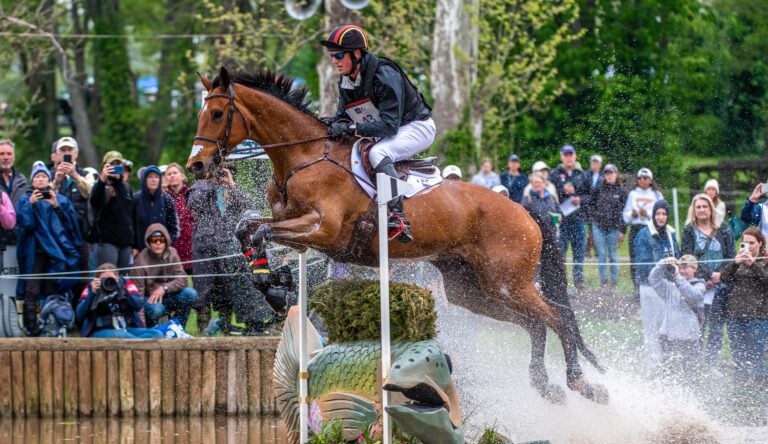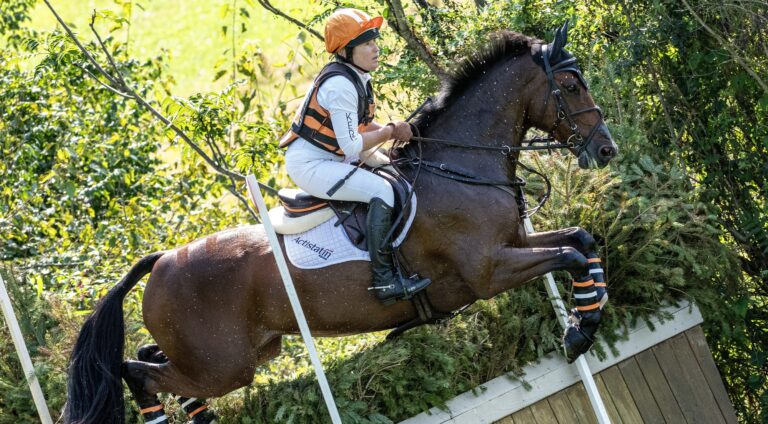December 11, 2016 — A convention of equestrians in South Florida during December? Sounds like fun. But the weather was dreary all weekend for the U.S. Eventing Association’s annual meeting, and it probably was just as well. Unlike other conventions of equestrian organizations I’ve attended, USEA offers a heavy education component for members, in addition to the usual business and break-out sessions geared mostly toward high-level riders or those on committees.
With so many offerings worth sitting in on, there wouldn’t have been much time to laze in the sun (had there been some) or walk along the ocean anyway.
The convention was jam-packed not only with meetings, but also with emotion. The dynamic Diane Pitts stepped down as president amid many hugs, while the energetic Carol Kozlowski took over the post. Awards ceremonies brought their share of joy and tears. Discussions were full of heart-felt opinions and ideas. The whole thing was a collaborative experience between leadership and membership.
I was impressed, as always, with the enthusiasm of eventers. The turnout of 368 was very good, considering the proximity of the meeting to Christmas, and the cost of a hotel room and plane fare.
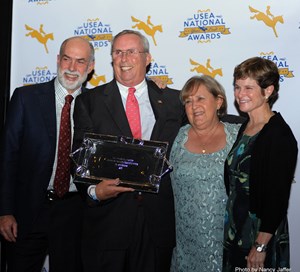 Volunteer extraordinaire Howard Simpson received the USEA’s lifetime service award from past president Kevin Baumgardner; Diane Pitts, who just stepped down as the organization’s president and Carol Kozlowski, the new president. | Photo copyright 2016 by Nancy Jaffer
Volunteer extraordinaire Howard Simpson received the USEA’s lifetime service award from past president Kevin Baumgardner; Diane Pitts, who just stepped down as the organization’s president and Carol Kozlowski, the new president. | Photo copyright 2016 by Nancy JafferUSEA is an impressive organization, not only because of the tip-top staff, but also due to the volunteers who govern and do so much in many other ways to make the sport run.
The epitome of that is Howard Simpson, who received the organization’s lifetime service to eventing award. I’ve known Howard as a doer who can be tough and all business when necessary, but he also has a soft side. Click on this soundbyte and listen to the chat we had moments after he accepted the silver tray emblematic of his honor.
Howard was responsible for insuring the future of the North American Junior and Young Riders Championships when they seemed in jeopardy. He worked tirelessly to make sure they continued and became a destination event, even hosting it 14 times at Tempel Farms in Illinois, starting in 1985.
Years ago, he told me why he was so involved with the championships: “When you watch the young athletes with their developing skill sets, it just fills your heart. How can you turn down the kids and not give them the opportunity to be the best they can be?”
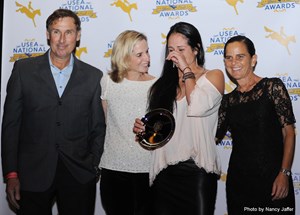 Kevin Keane, Evie Dutton and Caroline Moran presented the Connaught award for Stella Artois to Jennie Brannigan, who also got the $30,000 Rebecca Broussard grant. | Photo copyright 2016 by Nancy Jaffer
Kevin Keane, Evie Dutton and Caroline Moran presented the Connaught award for Stella Artois to Jennie Brannigan, who also got the $30,000 Rebecca Broussard grant. | Photo copyright 2016 by Nancy JafferBeing the best they can be actually is, of course, a common goal among those dedicated to equestrian sport. In eventing, it’s the same whether they’re at novice level or advanced. USEA’s new president understands that; she has been short-listed for the U.S. team, and successfully led the fight which ended the ridiculous requirement that event horses would have to compete carrying 165 pounds, no matter the weight of the rider.
Carol, who is remembered by those with a history in the sport from her days with the Connemara stallion, Hideaway’s Erin Go Bragh, seems to be a natural for presidential duties. Click on the right-pointing arrow to watch a video in which she talked about how she landed in the job, and one of her key goals.
The base of the sport is also being recognized by PRO, the Professional Riders Organization, which next year will become a new, broader-based group reaching out beyond the professionals. Details haven’t been announced, but I’ve been told that the professionals felt the group’s mission had been fulfilled by making more opportunities at the top end of the sport and that it was time to work with a larger constituency.
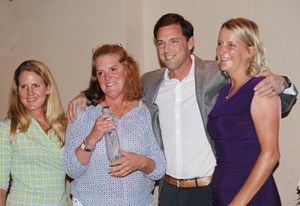 Allison Springer and Sara Murphy joined Nanki Doubleday as she accepted the PRO owner’s award after a wonderful tribute by rider Will Coleman. | Photo copyright 2017 by Nancy Jaffer
Allison Springer and Sara Murphy joined Nanki Doubleday as she accepted the PRO owner’s award after a wonderful tribute by rider Will Coleman. | Photo copyright 2017 by Nancy JafferEngaging the base is a goal of incoming U.S. Equestrian Federation President Murray Kessler, who noted at the USEA convention that his organization will be “going through a major overhaul,” as outlined in a strategic plan to be presented at his group’s annual meeting next month.
He gave a preview of some aspects, while conceding “many believe the USEF is too focused on the top end of the sport.”
Murray, who has traveled to a variety of affiliate meetings, including the saddlebreds and dressage, wants to have something for everyone. An online learning center, for instance, will feature videos on such varied topics as what to expect in your first riding lesson or walking a jumper course with McLain Ward. He believes USEF membership has to be more than “a fishing license” that equestrians need so they can compete; the idea is to get people involved even if they never show or event, but simply love to ride and enjoy horses.
He and I talked about the role of affiliates, such as USEA, in the big plan. Click on the soundbyte to hear what he had to say.
As is the case with USEF, education is key for USEA, and a fund started in the name of the late Roger Haller will cover all bases on that front. Roger was an official of the sport for decades. His expertise on rules and handling tough situations was invaluable and admired. I was curious about the blue WWRD wristbands that popped up at the convention. The letters stand for “What Would Roger Do,” and the $10 fee for buying one goes to the educational fund.
 Ann Haller spoke to the Saturday night awards dinner about her late husband, Roger Haller, after whom the USEA educational fund is named. | Photo copyright 2016 by Nancy Jaffer
Ann Haller spoke to the Saturday night awards dinner about her late husband, Roger Haller, after whom the USEA educational fund is named. | Photo copyright 2016 by Nancy JafferI asked Ann Haller, Roger’s widow, how the wristbands came about. Click on the soundbyte to listen to her answer.
The USEA’s board of governors heard an update by Dr. Suzanne Smith about a University of Kentucky research program the organization is funding to learn more about the dynamics of rotational falls as a step toward preventing them. Data is scarce, but the input of “citizen science” from riders and horse owners is being requested to measure many aspects of event horses’ bodies, along with their weight and height, to fill in the blanks about the physics of falls. Learning about problems posed by different types of jumps and the terrain in which they are set can be a tool for cutting down on accidents as well.
“We are accused of being too slow to respond to safety issues,” said Carol, but this initiative contradicts that contention. It is the type of thing USEA does so well in improving the sport.
“We understand the risks,” said course designer Morgan Rowsell, a new member of the board of governors, noting that by trying to mitigate them, “we are making our system safer and we’re being pro-active.”
He commented that while analytics aren’t new to sports, “they’re new to us,” and can provide a roadmap to risks and where things need to be improved.
Statistics? Boring, you say. Nope, not when they’re the focus of a talk presented by Sam Watson and Diarmuid Byrne of equiRatings, who used stats to correctly predict that France would win the eventing team gold at the Rio Olympics (and earn themselves some money in the process, since the bookies made them a profit by putting that country at 16-1 odds.)
The two friends, who went to school together through university level in Ireland, gave a fascinating talk before a crowd that was standing room only. They started their business informally, sitting at either end of a ping-pong table with their laptops. Now their company has grown to present data that can as they say, “create a competitive advantage on and off the field.”
Analytics also can be used for safety, pointing out horse/rider combinations or conditions that could cause problems. In addition, they are useful for engaging fan exposure and working with the media—giving it hooks on which to hang stories.
Click on the right-pointing arrow to see the video in which Diarmuid answered a few of my questions.
A highlight of the convention was the appearance of William Fox-Pitt, who had an incredible recovery from a life-threatening head injury he suffered in an October 2015 fall. At one point, his family was told he’d be a vegetable, but hard work through rehab and excellent medical care, not to mention his competitive spirit, got him to the Rio Olympics with Chilli Morning.
It’s really incredible, when you consider that earlier this year, the injury often caused him to see four jumps in his arena—one real, the others non-existent, caused by vision problems related to his accident. That could confuse his horses—though Chilli was fine with it. William said he often found himself sobbing for no reason, and had trouble with his sense of time, not a good thing for an eventer.
Through it all, he said, “My saving grace has been my family.”
His presentation also included engaging reminiscences of his horses. You’ll remember some of them, such as Tamarillo or Cool Mountain, while you may not have heard of Steadfast or Cosmopolitan from his early days in the sport.
I have spoken with William many times, after his triumphs at Rolex Kentucky and at various Olympics and World Equestrian Games, but I sensed a change in him since the accident. He was always very nice, though perhaps a bit reserved. Now that reserve seemed to be gone when we spoke. I asked him how what he went through had changed his perspective.
Listen in by clicking on the right-pointing arrow to see the video.
William pricked up his ears when Jim Wolf of Wolf Sports Group suggested he might like a catch ride in Florida’s $100,000 Wellington Eventing Showcase next year. The competition, held at the Adequan Global Dressage Festival grounds by Equestrian Sport Productions, always draws several riders from overseas. As Jim pointed out to an eager William, what’s not to like? Sunny Palm Beach County in winter, rather than cold England. The odds are for a better forecast there in February than we had this weekend.
Mark Bellissimo, the Winter Equestrian Festival impresario, has gotten into eventing in a big way after the success of the showcase. At the Tryon, N.C., International Equestrian Center in April, he’ll be holding the Fork eventing fixture with CIC’s from 1 to 3 stars for the first time. He was on hand at USEA to show a video of the considerable attractions at the facility, which also will stage the 2018 WEG.
His presentation had the right audience. Among the big names at the convention were such as David O’Connor, just reappointed as U.S. team technical advisor and chef d’equipe, who was busy giving all sorts of presentations himself; Allison Springer, Sinead Halpin, Doug Payne and Rio Olympic individual bronze medalist Phillip Dutton, who received the USEA’s Advanced Adult Rider of the Year award. Who else would you have chosen for this one? His Games mount, Mighty Nice, was the USEA’s Horse of the Year.
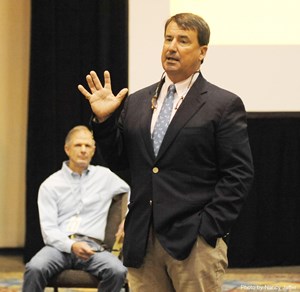 David O’Connor, who just got another two-year stint as the USEF eventing technical advisor/chef d’equipe, makes a point during a forum as course designer Derek DiGrazia looks on. | Photo copyright 2016 by Nancy Jaffer
David O’Connor, who just got another two-year stint as the USEF eventing technical advisor/chef d’equipe, makes a point during a forum as course designer Derek DiGrazia looks on. | Photo copyright 2016 by Nancy JafferMighty Nice, you’ll recall, had been owned by Bruce Duchossois, one of the great patrons of the sport before he died of cancer.
Phillip gave a talk on his experiences at the Rio Olympics, talking about his “save” that became a video sensation on YouTube. It was an incredibly astounding moment when Mighty Nice jumped the brush with his front end, but not his hind end. The rules, however, say only that the shoulder has to clear the flag.
“The backside of the brush showed up at the last stride,” Phillip commented, “and Mighty Nice veered. I just reacted. I did look down and saw that I was inside the flag, but you never know what the jump judge was going to say. I kept waiting to get pulled up. I was very lucky, but sometimes you need a bit of luck, don’t you?
Then he reached for another explanation: “I wonder if Bruce helped me stay inside the flags? Maybe he just pushed me over a bit.”
I have just hit a few of the highlights of the meeting. If you want to know more, go to www.useventing.com. I’m home for awhile now, thank goodness. So happy holidays to you and your horses—be sure to give them lots of carrots.
I’ll be on the road again next month, sending a postcard from the USEF convention and finding out more about Murray’s ambitious plans for the federation..
Until then,







